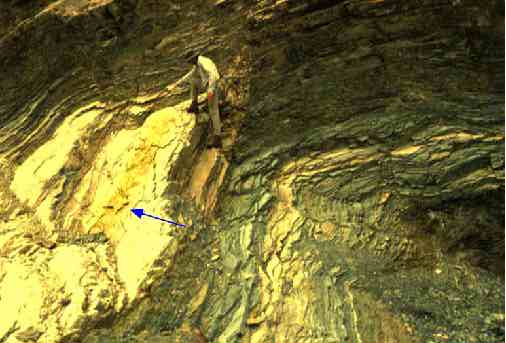Apparent and True Dip
 Cross-bedded building
stone. The contact immediately below A appears to dip gently to the
right, but at B, the contact appears to dip to the left. But it's not a
syncline! Both of those views are oblique, rather than perpendicular, to
strike, so they only give the apparent dip. Because strike is roughly parallel
to the plane of the photograph, the true dip of the bed comes directly
out of the screen.
Cross-bedded building
stone. The contact immediately below A appears to dip gently to the
right, but at B, the contact appears to dip to the left. But it's not a
syncline! Both of those views are oblique, rather than perpendicular, to
strike, so they only give the apparent dip. Because strike is roughly parallel
to the plane of the photograph, the true dip of the bed comes directly
out of the screen.

Hugh Hurlow emptying water bottle in desert.
As true dip is the steepest path down a planar surface, water will flow
directly down true dip--marked here by the blue arrow. Notice that these
foliation surfaces appear to dip gently to the left in the upper right
corner of the photo and appear to take a sudden turn just below the geologist's
left leg. But the surfaces are planar. The sudden turn is just the way
they appear when viewed from different angles. Incidentally, the geologist
who sacrificed his water to illustrate this phenomenon survived the ordeal.
Back to Structural Geology
 Cross-bedded building
stone. The contact immediately below A appears to dip gently to the
right, but at B, the contact appears to dip to the left. But it's not a
syncline! Both of those views are oblique, rather than perpendicular, to
strike, so they only give the apparent dip. Because strike is roughly parallel
to the plane of the photograph, the true dip of the bed comes directly
out of the screen.
Cross-bedded building
stone. The contact immediately below A appears to dip gently to the
right, but at B, the contact appears to dip to the left. But it's not a
syncline! Both of those views are oblique, rather than perpendicular, to
strike, so they only give the apparent dip. Because strike is roughly parallel
to the plane of the photograph, the true dip of the bed comes directly
out of the screen.